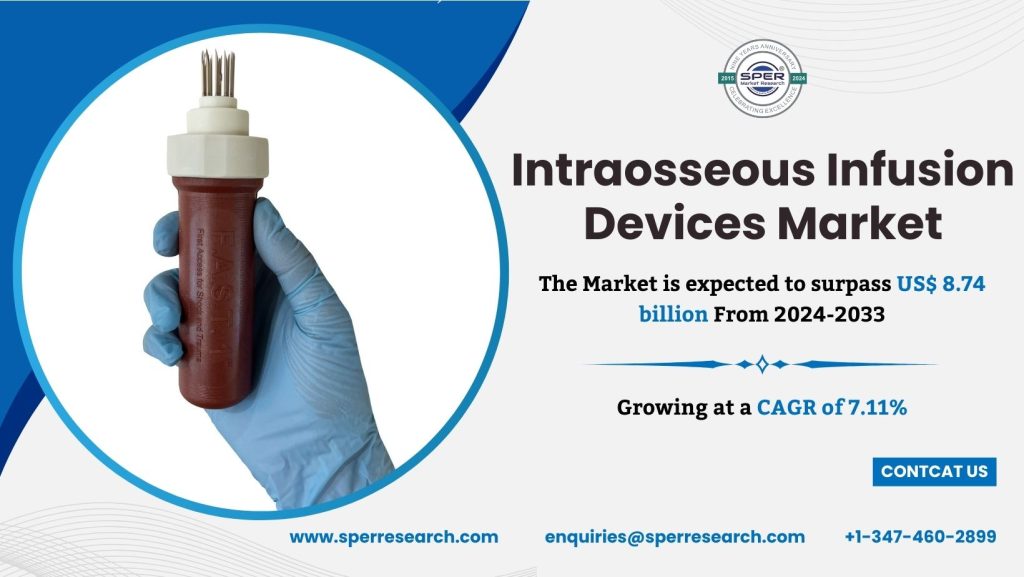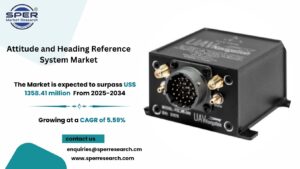Intraosseous Infusion Devices Market Revenue, Growth Drivers, Share, Demand, Challenges, Opportunities and Forecast Analysis till 2033: SPER Market Research

Intraosseous Infusion Devices Market
To provide an entrance site into the systemic circulation, any drugs or solutions are infused intraosseously into the human bone marrow. This method is typically used in situations where intravenous access is either impossible or unavailable. Additionally, this method is used for medicine delivery and vascular access in both adults and children. The sternum (FAST1), humerus EZ-IO, and proximal and distal tibia are often where the infusion is introduced.
According to SPER Market Research, ‘Global Intraosseous Infusion Devices Market Size- – By Product, By Route of Administration, By Technology, By End User – Regional Outlook, Competitive Strategies and Segment Forecast to 2033’ states that the Global Intraosseous Infusion Devices Market is estimated to reach USD 8.74 billion by 2033 with a CAGR of 7.11%.
Drivers: Due to several significant factors, the market for intraosseous (IO) infusion devices is growing. First, the growing prevalence of trauma and emergency medical conditions, where prompt and reliable intravenous access is crucial, has led to an increase in the requirement for IO devices. These devices are particularly helpful in emergency scenarios including shock, cardiac arrest, and accidents where quick venous access is required but difficult to obtain. The growing emphasis on improving patient outcomes in critical care settings—where IO devices are considered a life-saving substitute in the event that traditional IV access fails—is another important incentive. Technological advancements that have resulted in more efficient, user-friendly, and less intrusive technologies have also led to an increase in the use of IO devices.
Restraints: The high cost of intraosseous infusion (IO) devices and related consumables may restrict accessibility, especially in healthcare settings with limited resources; insufficient training for healthcare staff may result in improper use or incompetence in emergency situations; the risk of complications like infection, tissue damage, or incorrect insertion may discourage medical professionals from using IO devices instead of more conventional intravenous techniques; regulatory barriers and inconsistent national standards may further complicate the market, delaying the adoption and rollout of new products. These are some of the factors that could impede the growth and widespread adoption of the global market for IO devices.
Request For Free Sample Report @ https://www.sperresearch.com/report-store/intraosseous-infusion-devices-market.aspx?sample=1
Impact of COVID-19 on Global Intraosseous Infusion Devices Market
The global market for intraosseous infusion (IO) devices was significantly impacted by the COVID-19 pandemic’s changes to supply and demand. On the one hand, the pandemic’s increased demand for timely and efficient medical care—particularly in emergency and critical care settings where patient circumstances or a lack of accessible veins made traditional intravenous access more challenging—led to a rise in the use of IO devices. More interest in IO devices as a practical alternative to urgent fluid and medicine delivery was spurred by the pandemic’s increasing focus on making sure medical personnel had the resources they needed to treat critically ill patients.
Global Intraosseous Infusion Devices Market Key Players:
Additionally, some of the market key players are, Aero Healthcare, Becton Dickinson and Company, Biopsybell, Cardinal Health, Inc., Cook Medical Incorporated.
For More Information, refer to below link:-
Intraosseous Infusion Devices Market Growth
Related Reports:
Follow Us –
LinkedIn | Instagram | Facebook | Twitter
Contact Us:
Sara Lopes, Business Consultant – U.S.A.
SPER Market Research
+1-347-460-2899





